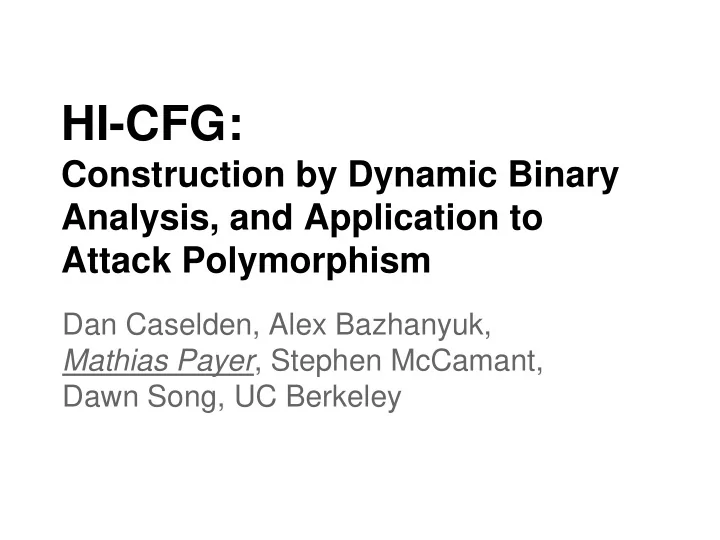

HI-CFG: Construction by Dynamic Binary Analysis, and Application to Attack Polymorphism Dan Caselden, Alex Bazhanyuk, Mathias Payer , Stephen McCamant, Dawn Song, UC Berkeley
Recovering Information Knowledge of information (data) flow and control flow of an application crucial for analysis • Current tools focus on just one type of flow Combine information flow and control flow into high-level data structure • Hybrid, Information- and Control-Flow-Graph (HI- CFG) using binary analysis
HI-CFG Overview CFG view Data flow view 1 Buffer A 2 Buffer B 3 4 Buffer C 5 6
Outline Motivation Attack Polymorphism Dynamic HI-CFG Construction Evaluation Conclusion
HI-CFG: Attack Polymorphism Step one: phase partitioning • Divide a computation into steps that transform data from an original input to an internal format • Based on HI-CFG buffers, information-flow and producer/consumer edges Step two: phase aware input generation • Aim is to produce an input that triggers a vulnerability deep within a program • Use phase structure to divide and conquer • Symbolic execution with search pruning
HI-CFG: Attack Polymorphism Program (with target condition) Input
HI-CFG: Attack Polymorphism Program (with target condition) Input buf0 buf1 buf2 trans. trans. trans. PoC Input
HI-CFG: Attack Polymorphism Program (with target condition) Input buf0 buf1 buf2 trans. trans. trans. PoC Input SE SE SE
Outline Motivation Attack Polymorphism Dynamic HI-CFG Construction Evaluation Conclusion
HI-CFG: trace-based construction 1/3 Trace enables us to recover both control-flow and information-flow of an application using some concrete input 1. Start with specific input data 2. Collect an instruction level trace (TEMU) 3. Process the traces to create a HI-CFG
HI-CFG: trace-based construction 2/3 Work through the execution trace and group “ related ” memory accesses • Categorize buffers hierarchically • Conservative and taint-based information flow Grouping heuristics • Instructions use same base pointer • Temporally and spatially correlated memory accesses
HI-CFG: trace-based construction 3/3 Apply graph partitioning algorithms to divide the HI-CFG at “ natural ” boundaries to separate code and data structures • Extract functionality into separate modules for reuse or transformation No source info needed, except addresses of malloc/calloc/free
Outline Motivation Attack Polymorphism Dynamic HI-CFG Construction Evaluation • Scalable Symbolic Execution • Poppler Case Study Conclusion
Scalable SE is key Vulnerability detection • Both in malware and legit applications Model extraction • Automatically learn security-relevant models Binary code reuse • Identify interface and extract components
Evaluation setup Simple transformation • RLE decoding • Output as target, SE produces input Configurations • KLEE • FuzzBALL Detailed results from TR Berkeley/EECS-2013-125
Limitations of SE
Limitations of SE Vanilla symbolic execution does not scale!
Transformation-aware SE Computations rely on input transformations Focus on transformations to reduce complexity • Surjectivity guarantees existing pre-image • Sequentiality ensures output is never revoked • Streaming bounds the transformation state Covered transformations include decryption, decompression, escape sequences, image or sound decoding
Feedback-guided optimization (FGO) Search pruning • if target “ unreachable ” Search prioritization • look for short inputs that maximize size of output Symbolic array accesses • treat choice of index like a branch (baseline) • combine all possible values into formula
Evaluation setup Simple transformation • RLE decoding • Output as target, SE produces input Configurations • KLEE • FuzzBALL • FuzzBALL-FGO
FGO: 1 order of magnitude
Transformation-aware SE Divide-and-conquer strategy for SE • HI-CFG captures transformations • Split SE on transformation boundaries
Evaluation setup Two transformations • HEX decoding • RLE decoding Different configurations: • KLEE/FuzzBALL • FuzzBALL-FGO • FuzzBALL-HI-CFG (includes FGO)
Transformation-aware SE: another 1 order of magnitude
Poppler Case Study Poppler PDF viewer • Type 1 font parsing vulnerability CVE-2010-3704 HI-CFG construction using benign document that loads a font • PDF generated by pdftex using a small tex file
Poppler Phases Read Flate Parse Font decode Font I/O
Poppler Buffers GfxFont::readEmbed FontFile(Xref*, int*) memcpy space alloc alloc alloc bf792000 828b420 829f008 82b7550 (implicit) 4096 312 34104 9887 FlateStream::getHuffmanCode FoFiType1 Word(FlateHuffmanTab*) ::parse()
Poppler Buffers GfxFont::readEmbed FontFile(Xref*, int*) memcpy space alloc alloc alloc Automatically produces compressed exploit bf792000 828b420 829f008 82b7550 (implicit) 4096 312 34104 9887 FlateStream::getHuffmanCode FoFiType1 Word(FlateHuffmanTab*) ::parse()
Outline Motivation Attack Polymorphism Dynamic HI-CFG Construction Evaluation Related Work Conclusion
Related Work HOWARD (Slowinska et al., NDSS’11, ATC12): Type and data structure inference from binaries • HI-CFG looks at code & relationships between code and data (not just data structures) AEG (Avgerinos et al., NDSS’11) and MAYHEM (Cha et al., Oakland’12 ): SE-based attack input generation • HI-CFG enables focus on iterative and scalable SE (not focus on coverage)
Outline Motivation Attack Polymorphism Dynamic HI-CFG Construction Evaluation Related Work Conclusion
Conclusion Presented HI-CFG as new data-structure • Construction from binary execution traces HI-CFG enables • Deep program analysis • Recover components from binaries • Guide SE along probable paths FuzzBALL symbolic execution engine: • http://github.com/bitblaze-fuzzball/fuzzball
Recommend
More recommend